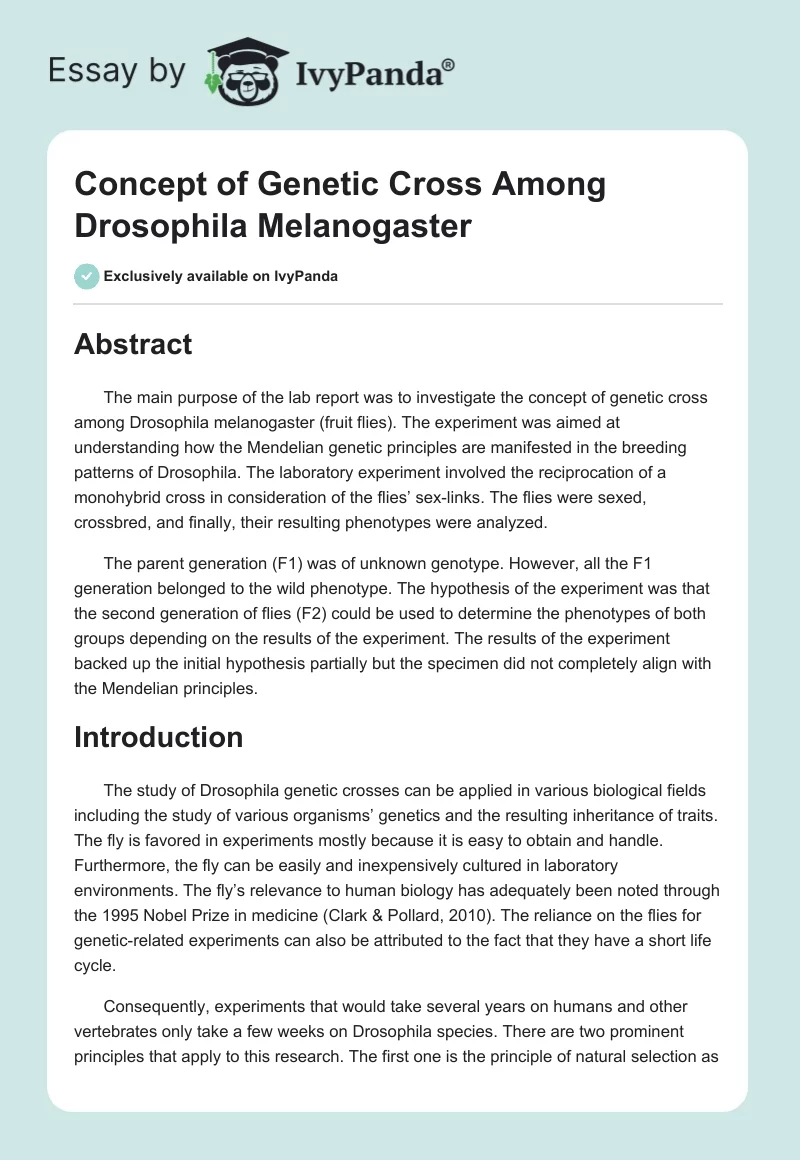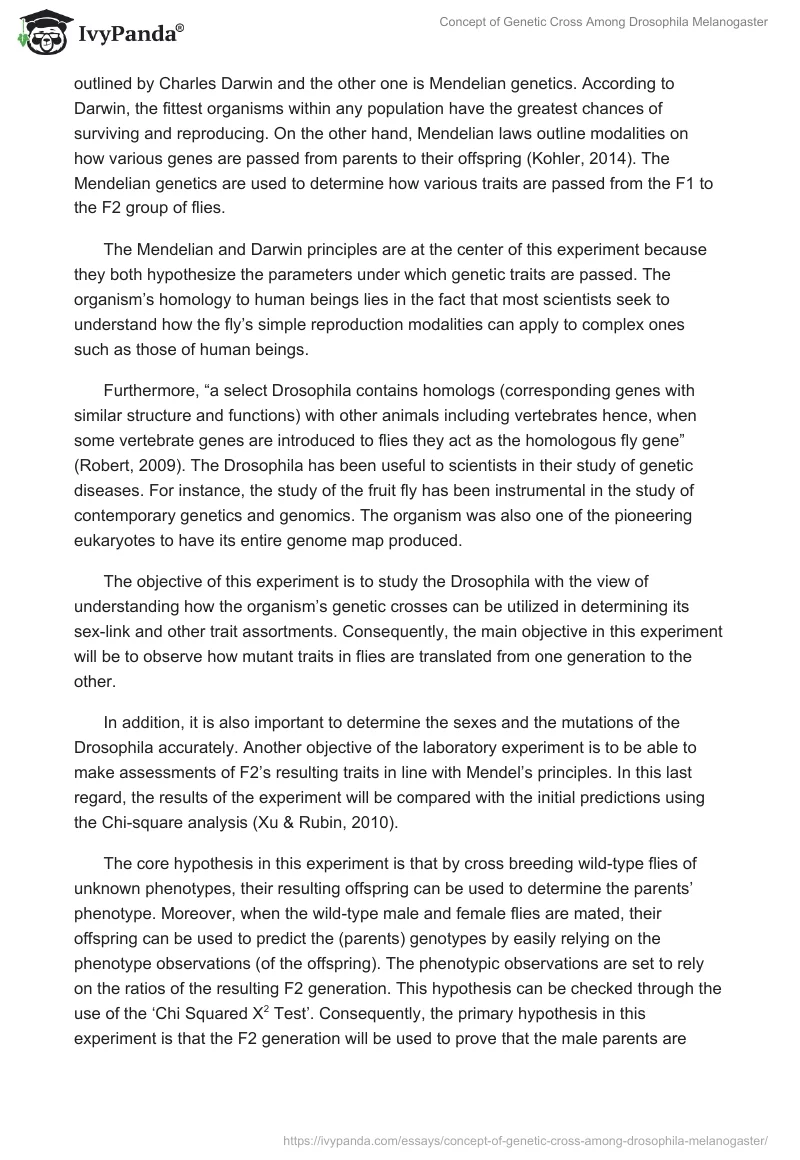Abstract
The main purpose of the lab report was to investigate the concept of genetic cross among Drosophila melanogaster (fruit flies). The experiment was aimed at understanding how the Mendelian genetic principles are manifested in the breeding patterns of Drosophila. The laboratory experiment involved the reciprocation of a monohybrid cross in consideration of the flies’ sex-links. The flies were sexed, crossbred, and finally, their resulting phenotypes were analyzed.
The parent generation (F1) was of unknown genotype. However, all the F1 generation belonged to the wild phenotype. The hypothesis of the experiment was that the second generation of flies (F2) could be used to determine the phenotypes of both groups depending on the results of the experiment. The results of the experiment backed up the initial hypothesis partially but the specimen did not completely align with the Mendelian principles.
Introduction
The study of Drosophila genetic crosses can be applied in various biological fields including the study of various organisms’ genetics and the resulting inheritance of traits. The fly is favored in experiments mostly because it is easy to obtain and handle. Furthermore, the fly can be easily and inexpensively cultured in laboratory environments. The fly’s relevance to human biology has adequately been noted through the 1995 Nobel Prize in medicine (Clark & Pollard, 2010). The reliance on the flies for genetic-related experiments can also be attributed to the fact that they have a short life cycle.
Consequently, experiments that would take several years on humans and other vertebrates only take a few weeks on Drosophila species. There are two prominent principles that apply to this research. The first one is the principle of natural selection as outlined by Charles Darwin and the other one is Mendelian genetics. According to Darwin, the fittest organisms within any population have the greatest chances of surviving and reproducing. On the other hand, Mendelian laws outline modalities on how various genes are passed from parents to their offspring (Kohler, 2014). The Mendelian genetics are used to determine how various traits are passed from the F1 to the F2 group of flies.
The Mendelian and Darwin principles are at the center of this experiment because they both hypothesize the parameters under which genetic traits are passed. The organism’s homology to human beings lies in the fact that most scientists seek to understand how the fly’s simple reproduction modalities can apply to complex ones such as those of human beings.
Furthermore, “a select Drosophila contains homologs (corresponding genes with similar structure and functions) with other animals including vertebrates hence, when some vertebrate genes are introduced to flies they act as the homologous fly gene” (Robert, 2009). The Drosophila has been useful to scientists in their study of genetic diseases. For instance, the study of the fruit fly has been instrumental in the study of contemporary genetics and genomics. The organism was also one of the pioneering eukaryotes to have its entire genome map produced.
The objective of this experiment is to study the Drosophila with the view of understanding how the organism’s genetic crosses can be utilized in determining its sex-link and other trait assortments. Consequently, the main objective in this experiment will be to observe how mutant traits in flies are translated from one generation to the other.
In addition, it is also important to determine the sexes and the mutations of the Drosophila accurately. Another objective of the laboratory experiment is to be able to make assessments of F2’s resulting traits in line with Mendel’s principles. In this last regard, the results of the experiment will be compared with the initial predictions using the Chi-square analysis (Xu & Rubin, 2010).
The core hypothesis in this experiment is that by cross breeding wild-type flies of unknown phenotypes, their resulting offspring can be used to determine the parents’ phenotype. Moreover, when the wild-type male and female flies are mated, their offspring can be used to predict the (parents) genotypes by easily relying on the phenotype observations (of the offspring). The phenotypic observations are set to rely on the ratios of the resulting F2 generation. This hypothesis can be checked through the use of the ‘Chi Squared X2 Test’. Consequently, the primary hypothesis in this experiment is that the F2 generation will be used to prove that the male parents are predisposed to wild type wings. On the other hand, the female parents are also predisposed to wild type wings with higher instances of mutant-type wings.
Methods
The experiment began by sorting out the flies according to phenotype and sex and then selecting four from each sex. The F1 generation of flies was not of any specific mutant trait and the sample consisted of a mix of mutations in regards to shapes, eye colors, antenna size/shape, and wing shape.
All the F1 mutations are noted for the purposes of comparisons with the F2 offspring. In this experiment, there are three distinct cross mutations namely monohybrid, dihybrid, and those with the white-eye recessives. The most important variables in this experiment involved the sterility rates of the males and the ability to sort out the flies accurately. The sterility of the samples is mostly dependent on the age of male flies. The ratios of F1 generation should also be random so as to add validity to the results of the experiment (Klemenz, Weber, & Gehring, 2012).
Results
The P1 sample group, which was used in monohybrid crossbreeding, consisted of four males and four females, all of different mutations. The ratios that are used in the F1 generation are selected randomly but under controlled environment. However, the resulting F2 generation (whose results are listed below) indicates that the results of the experiment bear an unexpected ratio. To gauge the validity of the experiment’s hypothesis, the Chi Test calculations are also demonstrated below.
This is the resulting data from the cross experiment
Those with the Monohybrid cross:
- Wild types; 99 males, 113 females
- Recessive phenotype; 10 males, 16 females
Those with a Dihybrid Cross:
- Wildtype; 96 males, 81 females
- Abb; 16 males, 28 females
- aaB; 26 males, 32 females
Groups with White Eye Recessive
- Wild types; 14 males, 32 females
- White eyes; 16 males, 0 females
Analysis: The Chi Square Test
- Consequently, the Chi Square Test statistic = 4.6874
- Degrees of freedom = 4
- Level of significance = 0.6874
From the above findings, it is imprudent to reject the hypothesis that was forwarded at the beginning of the experiment.
Discussion
The results of this experiment are mainly dependent on the proposed hypothesis. At the beginning of the experiment, it was proposed that the results of this experiment will prove that the both the male and female parents are wild-type but the latter are also predisposed to having mutant wings. The Chi Test calculations indicate that this hypothesis is accurate to a certain degree.
The final value of the Chi Test was found to come to 0.6874, and this acted as proof of the proposed hypothesis because the value was greater than 0.05. Therefore, the results of the experiment are understood to mean that the hypothesis of the study was near accurate. It is also important to note that the figure that was obtained through the Chi Test validates the Mendelian principles and eliminates the probability that the results of the experiment are the product of mere chance.
Even though the results of the calculations indicate that the hypothesis has high levels of accuracy, it is still not yet completely accurate. This indicates that some errors were present during calculations or in relation to the Mendelian principles. Human error is one of the most probable impediments to the experiment’s accuracy. For instance, analyzing the fruit flies one by one was a difficult task and some of them might have died in the process. The tiresome process might also have made it difficult for observers to distinguish the flies’ eye color and gender accurately.
In future, the experiment’s accuracy can be improved by ensuring that other types of organisms, whose traits are easily distinguished, are used instead of flies. Although an experiment that uses such organisms might take longer, the shift is likely to improve overall accuracy levels. The experiment validates the Mendelian principles and puts a stamp of approval on Darwin’s theories (Sturtevant, 2013). Nevertheless, more research is required to distinguish the various accuracy levels between the two principles.
References
Clark, A. G. & Pollard, D. A. (2010). Evolution of genes and genomes on the Drosophila phylogeny. Nature, 450(7167), 203-218.
Klemenz, R., Weber, U., & Gehring, W. J. (2012). The white gene as a marker in a new P-element vector for gene transfer in Drosophila. Nucleic Acids Research, 15(10), 3947-3959.
Kohler, R. E. (2014). Lords of the fly: Drosophila genetics and the experimental life. Chicago: University of Chicago Press.
Robert, J. (2009). Genetics analysis & principles. New York: McGraw Hill International Edition.
Sturtevant, A. H. (2013). The linear arrangement of six sex‐linked factors in Drosophila, as shown by their mode of association. Journal of Experimental Zoology, 14(1), 43-59.
Xu, T., & Rubin, G. M. (2010). Analysis of genetic mosaics in developing and adult Drosophila tissues. Development, 117(4), 1223-1237.


